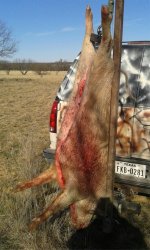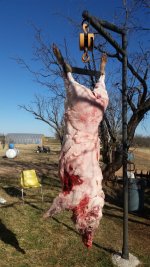If you go into a meat market and request "cottage bacon" you will get a bacon that is made out of the front shoulder or upper neck area. It is not pork jerky, it bacon. The gen x and millennial generation like this because it comes in larger pieces, not strips and they want it for their BLT sandwiches. It is a very good tasting bacon, less fat, and most importantly it don't fall out of the sandwich as easy. Kids can handle it better. I know this because my granddaughters told me so
I grew up in the NW Minnesota. It was 12 in1955 before we got electricity. When we butchered hogs, they were shot. and hooked up to a block & tackle and hung up immediately. The throat was cut and Mom and Grandma were there with a big dish pan to catch all the blood, mix it with flour and other stuff and blood sausage was made. There was a big cast iron kettle, it held about 20 gal water, that was hanging over a fire boiling the water. A large wooden barrel was placed under the hanging hog.The boiling water was poured into the wooden barrel, into which the hog was lowered with the block and tackle to scald it. Most pigs were to large to completely immerse them in it , so you dunked them a couple of times until the hair could be pulled out. then you picked them up, by the other end and dunked the other end of the hog to get the hair loose on the other half. You then laid them on the hay rack wagon and scraped them, maybe dumping some more hot water on them to help lssen up any hair that was still tight
Butchering hogs was a family affair, it was a lot of work, required everyone to pitch in and help, and t took all day, It required at least a couple men to handle the hog and block and tackle, and they also scraped the hog. My big sister drove the tractor when the hay wagon was moved back and forth. She helped mom clean the intestines and stuff for sausage makings. My sister and I were the youngest, our job was tending the fire and carrying water.
We never ate tripe (the stomach), but the head was saved and head cheese was made from it. The feet were pickled, the hocks were either pickled or smoked, depending on the size of the hog. The heart, liver and tongue were saved, the german neighbors ate the brains and kidneys (sweetbreads), when the lard was rendered, cracklings that came from rendering lard made great sandwiches, on home made buns and BBQ sauce. If the pork chops were going to be kept into the warm weather (remember no electric) they were packed in a crock jar in lard and kept in the ice house. Ice that we cut in the winter, packed it in saw dust is what we used in the icebox to keep foods cool.
We weren't the the only ones that did this, all of our neighbors did it also. We owned the big cast iron kettle, I still have it. The neighbors would borrow the kettle and on occasion help us butcher to return the favor. The kettle traveled alot. As I described this process to you, as you can see it was not done in he most sanitary conditions. Oh yes, we tried to keep things as clean as possible, but it was done outside, under the butcher tree. Hay racks and fairly clean tarps if there is such a thing, to lay the meat on. No stainless steel tables or tubs, no meat inspectors, we used the intestines, bladders and cleaned them out by flushing the in the water tank where the 10 gal milk cans cooled before the cream truck came to pick them up. As look back to those days, at all the people handling their meat very similarly, a few probably worse. I remember of not seeing or hearing of one person getting sick from contaminated meat. Not a single one! So why today do people get sick from lettuce, tomatoes, muskmelons, and meat that is recalled and destroyed by the hundreds of tons. With all the regulations and inspections in place our food safety should be guaranteed. I get that it's the assembly line process, I get that they process huge quantities of meat in an hour. But in my opinion the big difference is we gave a damn, and worried about the meat. In these packing plants, starting at the top man and coming down to the bottom grunt, they are worried only about the money left on bottom line, and don't give a damn about the meat.
I must apologize, I meant to tell you about butchering in the old days, but it ended up in a rant, I'm sorry, i could have deleted it, but truthfully, I didn't want to.
\




